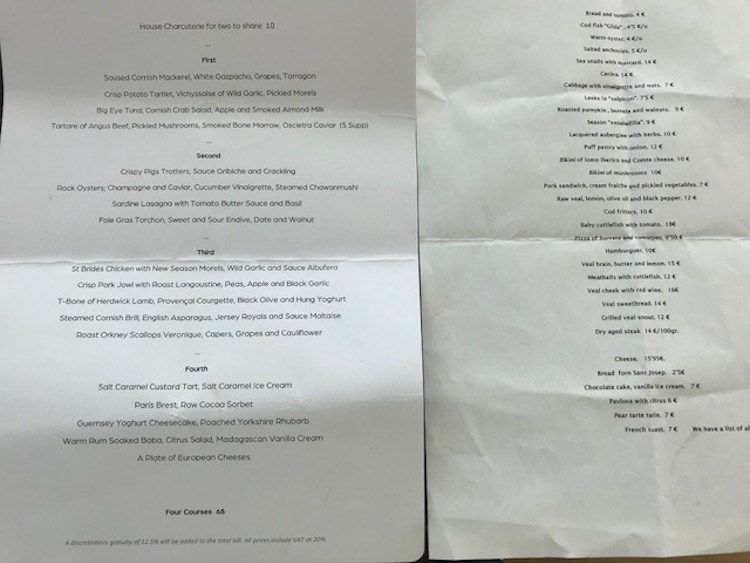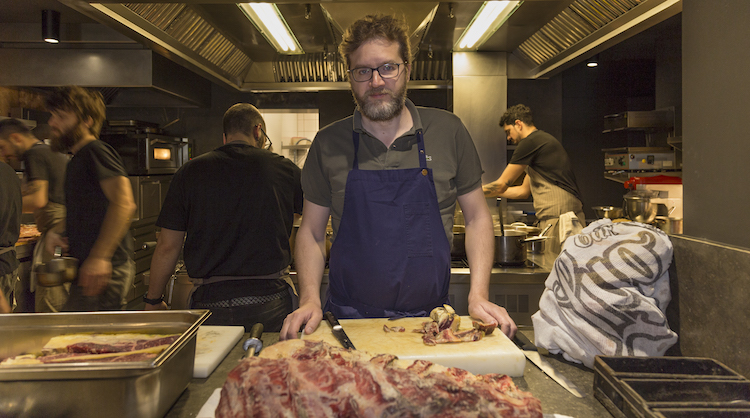The two menus (battle-worn, from a reviewer's pocket) shown below share several similarities. Both are written quite plainly in black ink on a single sheet of white paper. Both exude a certain simplicity that rests on their respective chefs' independent decision to work exclusively with the best seasonal ingredients. And yet these two restaurants are nearly 1,000 miles from each other.

The first menu, on the left, is from Trinity in Clapham, south London, while the rather simpler one on the right is from the bar side of Gresca restaurant in Barcelona. These two restaurants belong to chefs who between them seem to have all the physical characteristics necessary today for success in this demanding business.
Adam Byatt (top right) is the chef/proprietor of Trinity, the restaurant that he opened here in 2006. As well as having a particularly sharp haircut, Byatt can field a panoply of tattoos, as revealed by his short-sleeved shirt, though he is a generation above hipster. Rafael Peña, the chef/proprietor of Gresca, may or may not be tattooed – he was wearing a long-sleeved shirt on the two occasions I met him in Barcelona a month ago – but like Byatt he does sport a full, if slightly greying, beard (he is 42, after all). Both sets of kitchen staff are similarly attired, including the odd flat cap.
Byatt, born in 1974, is the slightly older of the two but both share two more features that have combined to shape their progress and have helped them to write such interesting menus.
The first has been their culinary education. Byatt was born into a cooking household (his grandfather and his mother were cooks before him) and on the eve of his sixteenth birthday he was taken on via the Savoy Education Trust as an apprentice chef at Claridge’s Hotel under its renowned chef John Williams. Byatt then worked under Philip Howard at The Square, where he rose to become sous chef.

Peña (above) did not attend cookery school either and also worked in a succession of top restaurants: the Neichel, then a two-star Michelin restaurant in Barcelona, before moving on to work under Martin Berasategui of San Sebastian and Ferran Adrià at El Bulli. In 2006, the same year that Byatt was opening Trinity with the help of his wife (their teenage son also works the occasional shift for pocket money as a waiter), Peña opened Gresca, which means 'party' in Catalan, with his wife Mireia Navarro.
So what, other than a long and formal training under a succession of leading chefs, and marital involvement with the business, have the careers of Byatt and Peña had in common? Two more interconnecting factors at least.
The first is that the route to the top in this profession, a career after all that they both chose for themselves, is long, hard and uncompromising. A young chef has to be committed and dedicated. These two men have been at the stoves for over 20 years in Peña’s case and almost 30 in Byatt’s. For their customers’ sake I would wish them the same again – although this may be something that they do not wish for themselves!
The second is their approach to cooking. Choosing the correct seasonal ingredients is the first, and possibly the easiest part of any chef’s job specification. But it is what they do with them afterwards that is so vitally important.
Ingredients, whether fish, vegetables, meat or even dairy products, have to be cooked, to be transformed to make them safe for human consumption at its most basic. And the maximum flavour of any ingredient depends on how much cooking a chef dares to undertake. On a flavour spectrum the maximum flavour comes with the maximum cooking to extract its inherent taste. A piece of meat cooked, initially, sous vide, and then finished will never, in my opinion, have the same flavour as the same ingredient carefully cooked in an oven or on the grill.
This approach to cooking is something that Byatt and Peña share and was very obvious in the two meals I enjoyed in their respective restaurants.
When Peña initially opened here in a building that had formerly been a Chinese restaurant, it was purely as a restaurant. When demand increased he decided to add a wine bar but faced a major structural challenge – a staircase leading to apartments above ran through the middle. A clever redesign by Cirera+Espinet, a Barcelona-based interior design company, has been to treat each as different spaces in which Peña and his team can offer different menus. His wine-bar menu, pictured here, offers two seatings every night at 8 and 10 pm while the other serves a more formal tasting menu, with choices, at around €70 per person for five courses. Both are served from what appears to be a rather crowded kitchen in the space that links the two at the rear.
We ate from the wine-bar menu beginning with cod fish Gilda, the fish being enlivened with the addition of guindilla peppers to produce a dish that is salty and spicy and is named after the 1946 film in which Rita Hayworth starred, a film that was a big hit in this part of the world. We then followed this with a dish of leeks in salpicon and one of the best aubergine dishes ever, Peña’s lacquered aubergines that reminded me of the Japanese version, nasu dengaku.
Veal featured heavily on Peña’s menu that evening across five different dishes: served raw with lemon and olive oil then as veal brain with butter and finally as a grilled veal snout. We settled for two interpretations, as a sweetbread and the veal cheek sautéed in red wine. For dessert we ended with a refreshing plate of a crunchy pavlova with citrus.
The menu at Trinity is more complex, innovative and structured (Byatt’s menu at his less expensive Bistro Union not too far away is much less so) with four courses for £68. But each of these was extremely imaginative, with each ingredient well thought out and on the plate for a purpose.
I actually chose three courses whose description began with crisp (not ‘crispy’ for once, thank goodness): a crisp potato tartlet filled with a creamy, solid vichyssoise of the palest green wild garlic and topped with pickled morels; crisp pig’s trotter with a sauce gribiche and crackling; and, perhaps best of all, and this is certainly a dish that you are unlikely ever to be offered in someone’s home, crisp pork jowl wrapped around a roast langoustine with peas, apple and black garlic. Desserts are given as much attention: salt caramel custard tart; a cheesecake made from Guernsey yoghurt on what appeared to be a draught board of Yorkshire rhubarb; and rum baba served with a sharp citrus salad and delicious Madagascan vanilla cream. Each provided a fitting finale to a very well thought out, structured and, above all, a very well executed meal.
So whether you are in the centre of Barcelona or in south London, rest assured that a highly professional chef is waiting there to cook for you.
Gresca Restaurant and Bar Provença 230, Barcelona; tel +34 93 451 61 93
Trinity 4 The Polygon, Clapham, London SW4 0JG; tel +44 (0)20 7622 1199














